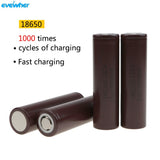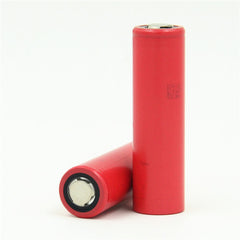Battery Chemistry
Here are some of the different cell chemistry offer:
- Lithium Manganese Oxide (LiMn2O4)High power but less capacity; safer than Li-cobalt; commonly mixed with NMC to improve performance.
- Lithium Cobalt Oxide (LiCoO2)Very high specific energy, limited specific power. Cobalt is expensive. Serves as Energy Cell.
- Lithium Nickel Manganese Cobalt Oxide (LiNiMnCoO2or NMC) Provides high capacity and high power. Serves as Hybrid Cell. Favorite chemistry for many uses. 800 - 1200 cycles.
- Lithium Iron Phosphate(LiFePO4) Very flat voltage discharge curve but low capacity. One of safest Li-ions. Used for special markets. Elevated self-discharge. 2000 cycles or more which means a 5 - 10 year battery.
Battery Cells How to break all this information down? (18650 Cells only)
Think of it like this the commonly used 18650 does not change in size at all but that "chemical mixture inside does very often depending on the company the cell comes from. We have already picked what we believe to be the best cells on the market for you but here is a summary of the different cells we use for you.



- Power cell - this is your battery that can handle the most power in terms of current. If you are planning on using a 1000W or higher motor and your controller allows more than 40 amp you might want to use a battery cell that can handle that large draw of current. Most cells in this range can handle between 20 - 30 amp of current.
- Life Cell - this is your battery that can last a long time over the years dude to the number of high cycles it has. Typically you might here about batteries that are limited in the total charge range and discharge range that is allowed which will increase your cycles. (Every notice that the LIFEPO4 cell doesn't charge all the way up to 4V) Most batteries in the range can last between 1200 - 2000 cycles.
- Range Cell - Also known as you high capacity cell this is where you are able to get the most out of every day rides. Although all lithium after the first 100-200 cycle will lose about 20% of power if you want the most out of ever charge you should consider a high range cell. Most batteries in this coloum will have between 3400mah - 3700mah
Battery Cell Types
- Cylindrical cell has high specific energy, good mechanical stability and lends itself to automated manufacturing. Cell design allows added safety features that are not possible with other formats, offers a long calendar life and is low cost, but it has less than ideal packaging density. The cylindrical cell is commonly used for portable applications.

- Prismatic cell are encased in aluminum or steel for stability. Jelly-rolled or stacked, the cell is space-efficient but can be costlier to manufacture than the cylindrical cell. Modern prismatic cells are used in the electric power train and energy storage systems.

- Pouch cell uses laminated architecture in a bag. It is light and cost-effective but exposure to humidity and high temperature can shorten life. Adding a light stack pressure prolongs longevity by preventing delamination. Swelling of 8–10 percent over 500 cycles must be considered with some cell designs. Large cells work best with light loading and moderate charge times. The pouch cell is growing in popularity and serves similar applications to the prismatic cell.

